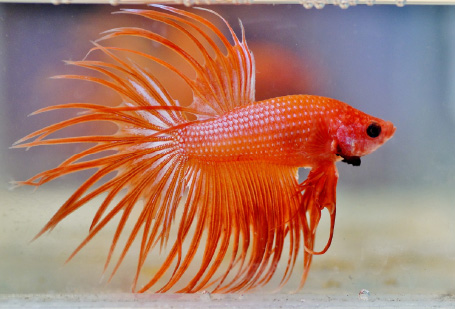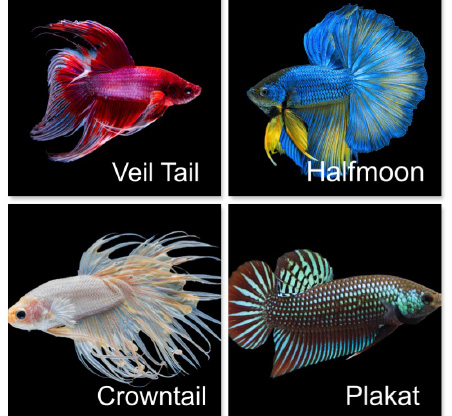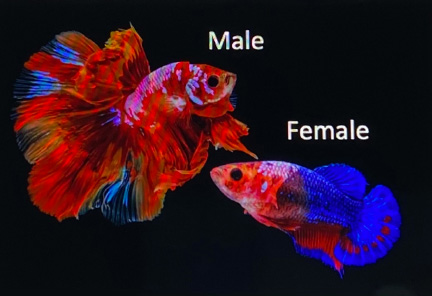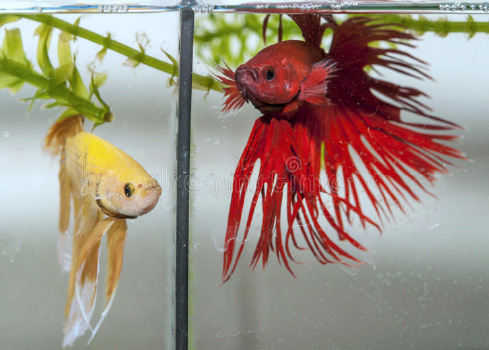The Basics For Betta Fishkeeping
By Lana Van De Mark
As I recall it was ten years ago when I walked into my local PetSmart and bought my very first betta fish. I was an amateur who knew very little about raising fish and had already failed on several attempts to properly maintain an aquarium full of Tetras and Mollies. I wanted to give up on the aquatic pet hobby the day I found my last Tetra wrapped around the filter. It was too heartbreaking to see these splendid creatures continue to die off one after another and frustrating to see more of my money go down the tubes. When I walked down that betta aisle though, I was mesmerized by their beauty and eager to buy one. I realized then that if I was going to make this investment and wanted to keep them around a long time then I needed to educate myself about the basics of properly caring for a betta. Over the past ten years I have raised nearly two dozen bettas and found my niche in the betta marketplace. For all of you fish lovers out there who are seeking to adopt a betta for the very first time and want to be able to give it the best care possible, here is some helpful information to consider before you make that trip to the pet store.

THE BETTA’S NATIVE HABITAT
Southeast Asia has been the native home to the Betta Fish for over 150 years. They are tropical freshwater fish located in the shallow ponds, streams, ditches and rice paddies of Thailand, Cambodia, Malaysia and Vietnam. Bettas are very territorial and known for their vibrant colors and aggressive behavior. In addition to their gills, bettas have lungs known as a labyrinth organ which gives them the ability to breathe air at the surface of the water. This unique organ is what sets them apart from other fish. The average life span of a betta is 2-4 years, but they can live even longer if they are properly taken care of. While named after an ancient Asian warrior tribe known as the Betta Tribe, they are also referred to as Siamese Fighting Fish in their native homeland of Siam (Thailand).
For centuries, bettas have been bred and caught to fight each other in betta matches in their native homeland. This act is still performed in parts of Southeast Asia, which continues to spark concern among animal rights activists and is banned in the United States. Today bettas are now exported worldwide by Southeast Asian and U.S breeders primarily for their exotic beauty and as aquatic pets.
VARIOUS TYPES OF BETTA TAILS AND BETTA GENDER
There are over 70 types of betta species out there that exist in the world, but these are the most common tail types you will find in pet stores. These fish typically grow to be about 3 inches. To learn more info and where to purchase visit tankarium.com

As a new Betta Keeper, it is important to be able to identify the differences between a male and female betta before purchasing one. Males have larger bodies, longer fins and more vibrant colors, where females have smaller bodies, shorter fins and a much duller appearance. To learn more visit aquariadise.com
Before you make your final decision on what type of betta you want, take a few moments to observe their behavior, appearance and water condition.
Signs of a healthy betta include:
- Swimming upright and in a full circle around their habitat
- Full finnage
- Normal colored body, scales intact
- Blackish/brown eyes
Signs of a sick betta include:
- Lagging at the bottom of the tank
- Swimming sideways or upside down
- Torn fins
- Bulging eyes and stomach
- Stringy, white substance hanging off their tail
- White or red spots on the body and scales

The quality of their water should also appear clean with no traces of food or debris floating around. Any debris or discoloration in their water raises the betta’s chances of getting sick, especially if they have been sitting on the store shelf in a tiny container for quite some time
TIPS FOR PROPERLY MAINTAINING A BETTA AQUARIUM
If you want to maintain a proper living environment for your betta, the following tips are highly recommended:
- Avoid bowls or aquariums smaller than 2.5 gallons. Small living spaces don’t allow bettas with larger bodies and fins to extend their body out as naturally as they should when they swim and that can cause long-term stress and damage to their tails and body.
- Use filtered water. Raw water contains chloramine which can be harmful to any fish. If you use tap you need to make sure you treat it first with anti-bacteria supplements and water conditioner.
- Maintain water temperatures between 78-80 degrees Fahrenheit. These temps are similar to the water conditions in their native habitat and what they need to thrive. Submersible heaters and thermometers are highly recommended for maintaining these temperatures.
- Test water conditions daily. Maintain PH levels between 6.8-7.5 and check water conditions using aquarium testing strips. PH levels can be adjusted by treating your aquarium with PH regulators and digital monitors.
- Keep your bettas separated. Males especially are more aggressive and territorial. Female bettas can be kept together if the aquarium is large enough, but it’s not 100% guaranteed. Aquarium dividers or betta aquariums are recommended.
- Avoid aquarium décor that is sharp and toxic. Male bettas can easily get their fins caught up on sharp plants if there is very little space for them to swim in. Some rocks and driftwood contain metal toxins and can increase PH levels that are fatal to your fish. Check with an aquatic specialist online or in store beforehand if you’re uncertain.
- Keep your bettas housed with only compatible tankmates. These include Cory Catfish, Feeder Guppies, Zebra Snails, Neon/Ember Tetras, Kuhli Loaches, Ghost Shrimp and African Dwarf Frogs. Multiple fish should be housed in at least a 10-gallon aquarium. To learn more info and where to purchase visit tankarium.com


BETTA NUTRITION
Bettas are carnivores and require a well-balanced, high protein diet. Their diet should include high protein betta pellets, betta flakes, freeze-dried worms and brine shrimp. Before you buy your food, make sure you read the labels to make sure they are betta specific and contain at least 40 % protein. Protein should be listed as the first ingredient. Omega One is a popular brand for bettas as it contains the required amount of protein they need to maintain a healthy diet. To learn more info and where to purchase
visit tankarium.com














